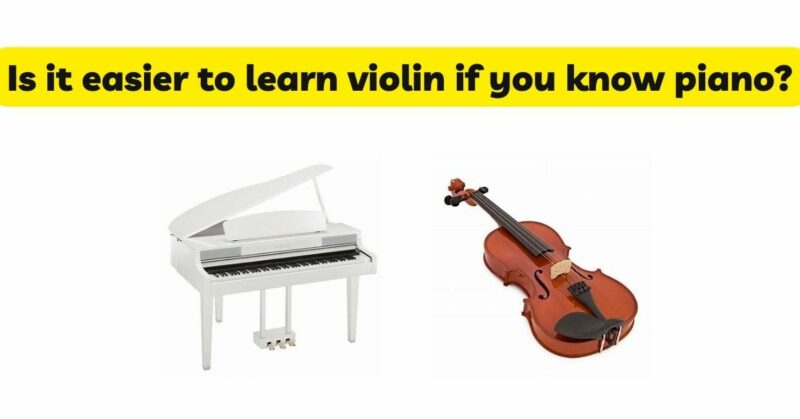Embarking on a new musical journey is an exhilarating experience, and for those who already possess piano skills, the idea of learning the violin holds a unique allure. The question often arises: does prior knowledge of the piano make it easier to learn the violin? In this article, we will explore the synergies and advantages that arise from knowing the piano when delving into the world of the violin. By examining the transferable skills, musical understanding, and technical foundations acquired from playing the piano, we aim to shed light on whether learning the violin is indeed easier for those with piano proficiency.
- Transferable Skills: One of the significant advantages of prior piano knowledge when learning the violin is the transferable skills gained from playing the piano. Reading sheet music, understanding musical notation, and interpreting rhythms are skills that piano players already possess. This familiarity with music theory and notation greatly eases the learning process when transitioning to the violin. The ability to recognize pitches, intervals, and dynamics acquired through piano practice also transfers well to the violin, making it easier to grasp the fundamental concepts of intonation, phrasing, and musical expression.
- Technical Foundation: Piano proficiency provides a strong technical foundation that can benefit violin learning. The coordination between both hands on the piano facilitates the transition to the violin, where coordination between bowing and fingering is required. Piano players are accustomed to independent finger movements, which is advantageous when developing finger dexterity and precise finger placements on the violin’s fingerboard. Additionally, the hand-eye coordination honed on the piano transfers well to the violin, aiding in bowing technique and hand positioning.
- Ear Training and Intonation: Piano players often have well-developed ears due to their exposure to different pitches, intervals, and chords. This ear training carries over to the violin and helps in developing accurate intonation. Piano players are already attuned to pitch relationships, which gives them an advantage in reproducing correct pitches on the violin. The ability to hear and reproduce accurate pitches enhances intonation and aids in producing a more refined and expressive sound on the violin.
- Musical Understanding and Expression: Piano players have a solid foundation in musical understanding, including dynamics, phrasing, and musical interpretation. This understanding transfers to the violin, enabling players to grasp the nuances of expression and musicality. The experience gained from playing the piano allows violin learners to better appreciate the nuances of dynamics, articulation, and emotional expression in their violin playing. Additionally, the ability to shape phrases and create musical narratives developed through piano practice contributes to a more expressive and nuanced interpretation on the violin.
- Familiarity with Music Theory: Knowledge of music theory acquired through piano study provides a valuable advantage when learning the violin. Concepts such as scales, key signatures, chord progressions, and harmonic understanding are already familiar to piano players. This understanding helps in grasping the structure and patterns within music, making it easier to learn new melodies, recognize chord progressions, and improvise on the violin. The solid foundation in music theory gained from piano study provides a head start in understanding the harmonic and melodic aspects of music, facilitating faster progress on the violin.
- Challenges and Differences: While prior piano knowledge offers advantages when learning the violin, it is important to acknowledge the challenges and differences between the two instruments. The physicality and technique required to play the violin differ significantly from playing the piano. Holding the instrument correctly, developing proper bowing technique, and adjusting to a new instrument’s smaller size can initially be challenging. Furthermore, the violin demands a heightened sense of body awareness and coordination between the bowing arm, fingers, and hand position. While the piano and the violin share similarities, it is crucial to approach the violin as a new instrument and be prepared to invest time and effort in acquiring its unique set of skills.
- Guidance and Learning Resources: While prior piano knowledge provides a solid foundation, seeking guidance from a qualified violin teacher is highly recommended when learning the violin. A skilled instructor can help piano players adapt their existing knowledge and technique to the specific requirements of the violin. Additionally, utilizing method books, online resources, and attending violin workshops or classes can further enhance the learning experience and aid in the transition.
Conclusion: The prior knowledge and skills acquired from playing the piano indeed offer advantages when learning the violin. Transferable skills, technical foundations, musical understanding, and familiarity with music theory create a synergistic learning experience. Piano players have an edge in reading sheet music, understanding musical notation, and interpreting rhythms, making the transition to the violin smoother. The hand-eye coordination, finger dexterity, and independent finger movements developed on the piano transfer well to the violin’s requirements. Furthermore, piano players possess a developed musicality, nuanced expression, and understanding of dynamics, which enriches their violin playing. However, it is important to acknowledge the challenges and differences between the two instruments and approach the violin as a unique endeavor. Seeking guidance from a qualified violin teacher and utilizing available learning resources will further facilitate the learning process.


